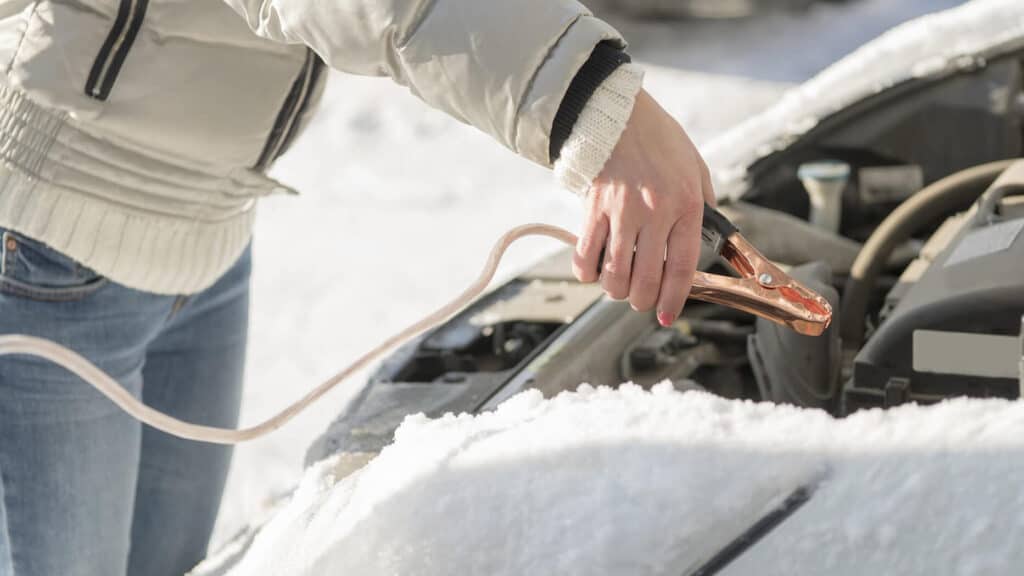Introduction: “In the Face of the Elements: The Impact of Weather on Battery Performance”
When it comes to weather, your car battery isn’t just idly sitting by. It’s a dynamic player responding to every degree change. Let’s explore how these unseen forces of temperature impact your daily drive.
Thermal Impact: How Temperature Influences Battery Performance
If batteries could talk, they’d have a lot to say about temperature! Much like your favorite ice cream melting on a hot day or freezing into a rock-solid mass in the freezer, batteries have a finicky relationship with temperature. In the sweltering heat, they might overheat, leading to faster degradation, while in the cold, they might not perform as well. It’s like taking a perfect chocolate chip cookie out of the oven; too early and it’s doughy, too late and it’s burnt. Understanding the thermal impact on batteries is a bit of a culinary art, where the ingredients are complex chemicals and the oven temperature is the weather outside.
Navigating this complex relationship requires knowledge and care. We’ll explore the chemical reactions happening inside the battery, how temperature can alter these reactions, and what that means for your car’s performance. You’ll gain insights to keep your battery cool as a cucumber or warm as a fresh muffin, depending on the weather. Like a chef perfecting a recipe, knowing how to manage the temperature’s influence on your battery can lead to the best performance and longer life. After all, the ideal battery is one that is well-nourished, cared for, and prepared to tackle the Canadian elements!

Climate vs. Battery Life: Understanding the Direct Correlation
1. Cold Climate Impact: A Battery’s Winter Challenges
• Delayed Chemical Reactions: Extreme cold can slow down the chemical reactions within the battery, reducing its efficiency.
• Increased Thickness of Electrolytes: Cold temperatures cause the battery’s electrolytes to become thick and sluggish, hindering the battery’s ability to function.
• Starting Struggles: In freezing temperatures, the engine requires more energy to start, putting additional strain on the battery.
• Battery Preservation in Cold: Using a battery warmer, keeping the battery charged, and regular maintenance can help combat cold-related issues.
2. Hot Climate Impact: A Battery’s Summer Struggles
• Fluid Evaporation: High temperatures lead to fluid evaporation inside the battery, affecting its ability to hold a charge.
• Increased Rate of Corrosion: Hot weather can increase the rate of internal corrosion, further compromising battery performance.
• Shortened Lifespan: Overheating due to hot climate can cause accelerated wear and tear, leading to a shortened battery lifespan.
• Heat Mitigation Strategies: Regularly checking fluid levels, proper insulation, and shade-parking are strategies to counter the heat’s negative effects.
3. Moderate Climate: The Sweet Spot
• Ideal Temperature Range: Understanding the optimal temperature range for your battery helps in maintaining its efficiency.
• Seasonal Maintenance: Tailoring your battery care routine to the season can keep it performing at its best year-round.
• Avoiding Extreme Temperature Exposures: Minimizing exposure to extreme temperatures by using garages or shades can prolong battery life.
4. Electric and Hybrid Cars: A Special Consideration
• Unique Sensitivity: Electric and hybrid car batteries have unique temperature sensitivities and may require specific climate-related care.
5. The Right Battery for Your Climate: Choosing a battery designed to withstand your specific climate can save you both time and money in the long run.
So, whether you’re facing the icy kiss of a Canadian winter or the sweltering embrace of a hot summer, being aware of the direct correlation between climate and your car battery’s life can keep you motoring on with confidence. Consider this your car battery’s personal weather forecast – with a bit of wisdom and proper care, every day can be a perfect driving day!
Electric Car Battery: The Unique Impact of Temperature
You bet, and they’re as sensitive as a fine-tuned thermometer! Electric car batteries have unique characteristics that make them more susceptible to temperature changes. Whether it’s a sweltering hot day in July or a freezing cold morning in January, temperature can impact charging efficiency, range, and overall performance. In the heat, the battery can overheat, affecting its lifespan, while in the cold, the battery’s capacity might be reduced, restricting how far you can travel on a full charge. It’s like a delicate ballet where the temperature leads, and the battery must follow in step.

Understanding this dance is vital for electric vehicle owners. Knowing how to manage these temperature effects through proper care and charging habits can lead to optimal performance. From utilizing preconditioning to maintaining optimal charging levels and considering the type of charger used, owners can extend battery life and efficiency. So, as you cruise the streets of Ontario, you can be confident that your electric car’s battery is ready to perform its best dance, no matter the weather. Now that’s a symphony of mechanics and meteorology!
“Sweet Spot: Identifying the Ideal Temperature for a Car Battery” What is the best temperature for a car battery?
Finding the sweet spot for your car battery is akin to finding the perfect pillow at a luxury hotel. It’s not too hard, not too soft, but just right. In this section, we’ll explore the perfect temperature range, usually around 20°C to 25°C, where your battery operates at peak efficiency. It’s like creating the perfect environment for a tropical plant; anything too hot can cause dehydration, and anything too cold can lead to frostbite. This optimal temperature range allows the chemical reactions inside the battery to occur at just the right rate, ensuring that everything is working smoothly and efficiently.
Knowing how to maintain this comfort zone is essential, especially for those braving the varying climates of Canada. Various protective measures, such as parking in the shade during hot days or using a garage in extreme cold, can make a big difference. We’ll guide you on these and more ways to recognize when conditions are veering into the danger zones of too hot or too cold. Like a well-tended garden, your battery thrives when conditions are ideal, ensuring that you’re never left stranded, no matter what the thermometer reads. Keep your battery cozy, and it’ll return the favor by powering your journeys with trusty reliability.
The Heat is On: How Car Batteries React to High and Low Temperatures
1. High Temperatures: A Battery’s Summer Woes
• Overheating Risk: Prolonged exposure to high temperatures can cause a battery to overheat, leading to internal damage.
• Fluid Evaporation: Extreme heat can evaporate the battery’s internal fluids, affecting its ability to hold a charge.
• Accelerated Wear and Tear: Hot temperatures can accelerate the wear and tear process, shortening the battery’s overall lifespan.
• Tips to Combat the Heat: Proper insulation, regular checks, and parking in the shade can help maintain optimal battery performance in hot weather.
2. Low Temperatures: A Battery’s Winter Blues
• Sluggish Performance: Cold temperatures slow down the chemical reactions within the battery, causing it to struggle to deliver sufficient power.
• Thickening of Fluids: Cold weather can cause the battery’s internal fluids to thicken, hindering its ability to function properly.
• Starting Troubles: Extremely low temperatures might make it challenging to start the car, as the battery has to work harder.
• Tips to Face the Freeze: Keeping the battery fully charged, using a battery warmer, and regular winter maintenance can alleviate some of the cold-related challenges.
3. Balancing Act: Maintaining Optimal Performance
• Understanding Your Battery’s Needs: Knowing your battery’s specifications and temperature tolerances can help you care for it better.
• Regular Maintenance: Seasonal checks and proper maintenance will ensure your battery’s performance stays consistent, no matter the weather.
• Knowing When to Replace: Being aware of the signs of a failing battery and knowing when to replace it can save you from getting stranded in extreme temperatures.
So, whether you find yourself in a Canadian heatwave or a bone-chilling winter storm, understanding how your car battery reacts to these temperature extremes ensures that you’ll never be left out in the cold (or heat)! Think of it as dressing your battery for the weather – a light jacket for the summer and a cozy scarf for the winter. It’s fashion, but for batteries!

“Humidity and its Effects on Car Batteries” Does humidity affect car batteries?
It’s not all about degrees on the thermometer; humidity can be the secret saboteur, slowly degrading your battery’s performance. Imagine humidity as a sneaky villain in a cloak, lurking around your battery, trying to ruin its good day.
• Corrosion Culprit: Humidity can create an environment where corrosion thrives, especially around the battery terminals. It’s like rust slowly eating away at a piece of metal; it might not be noticeable at first, but over time, it weakens the structure. By recognizing the signs of corrosion and knowing how to prevent it, you can keep this sneaky villain at bay.
• Electrolyte Enigma: The electrolyte levels in your battery can be affected by humidity. Too much moisture can lead to overfilled electrolytes, while too little can lead to drying out. It’s a delicate balance that requires just the right touch, much like seasoning a fine dish to taste.
• Charging Challenges: Humidity might even interfere with the charging system, causing inconsistencies and frustrations. Understanding how to navigate these challenges is akin to knowing the rules of a complex game. With the right moves, you can win every time.
• Weathering the Storm: Canadian weather isn’t just about cold winters; humidity plays its part too. Knowing how to handle your battery in varying humidity levels is like having an umbrella ready for a sudden rain shower. It keeps you prepared and moving forward, no matter what the weather throws at you.
By understanding this often overlooked factor, you’ll be armed with the knowledge to ensure your battery stays robust, rain or shine. Like knowing exactly how much sugar to put in your tea, recognizing and managing the effects of humidity on your battery will make your driving experience just right. After all, in the world of car batteries, it’s not just the heat; it’s the humidity!
Conclusion: “Weathering the Storm: Choosing the Best Battery for High Temperatures and Ensuring its Longevity”
We’ll wrap it all up with solid advice to keep your battery thriving in any Canadian weather. Be it rain, snow, or shine, your car’s battery will be ready to take on the elements with grace! If you’re looking for the perfect solution to these weather-related challenges, don’t forget to turn to Uchaincs, a mobile mechanic company in Canada that’s well-equipped to handle all your car battery needs.
